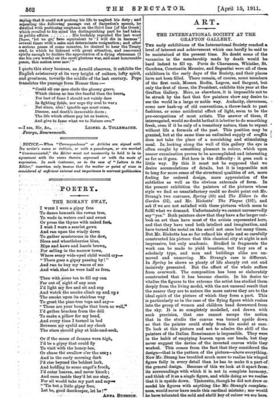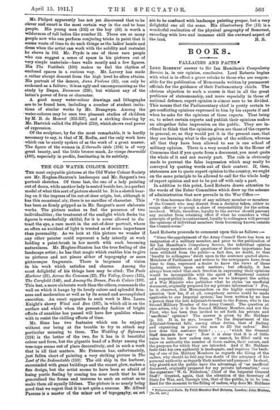ART.
Tabs INTERNATIONAL SOCIETY AT THE, GRAFTON GALLERY.
THE early exhibitions of the International Society reached a level of interest and achievement which can hardly be said to be maintained at the present time. No doubt some of the vacancies in the membership made by death would be- hard indeed to fill up. Pavia de Chavannes, Whistler, St.
Gaudens, Constantin Meunier, and Segantini were all of them exhibitors in the early days of the Society, and their places have not been filled. There remain, of course, some members of the first rank, Messrs. Rodin, Legros, and Sargent, but only the first of • these, the President, exhibits this year at the Grafton Gallery. Here, as elsewhere, it is impossible not to be struck by the fact that few painters show any desire to, see the world in a large or noble way. Audacity, cleverness, some new hash-np of old conventions, a throw-back to past fashions, or some accidental effect of light, seem to be the pre-occupations of most artists. The answer of these, if
interrogated, would no doubt be that it is better to do something fresh, even if it be only of a transitory nature, than to repeat without life a formula of the past. This position may be granted, but at the same time an unlimited supply of souifies does not take the place of a nourishing and stimulating meal. In looking along the wall of this gallery the eye is often caught by something pleasant in colour, which upon nearer examination proves to be accomplished and interesting
as far as it goes. But here is the difficulty : it goes such a little way. By this it must not be supposed that we desire accumulations of details, but it is impossible not
to long for more sense of the structural qualities of art, more feeling for ordered design, more appreciation of the subtleties as well as the obvious externals of form. In the present exhibition the painters of the pictures whose style we find so unsatisfactory could no doubt point out Mr. Strang's two canvases, Spring (50) and The Elders in the Garden (52), and Mr. Ricketts' The Plague (101), and ask if we are not satisfied with these pictures which seem to fulfil what we demand. Unfortunately we cannot unreservedly say "yes." Both painters show that they have a far larger out- look on art than have most of the artists represented here,
and that they have used both intellect and imagination, and have turned the metal on the anvil not once but many times.
But Mr. Ricketts has so far refined his style and so carefully constructed his picture that this classical city at night is not impressive, but only academic. Studied in fragments the work can be made to yield beauties, but they are of a scholarly type, and men and buildings alike are un-
moved and unmoving. Mr. Strang's case is different.' In Spring he shows us plenty of life sharply cut out and incisively presented. But the effect of the whole suffers from overwork. The composition has been so elaborately constructed that it has become chaotic. In his desire to-
vitalise the figures to the extreme the artist has studied them deeply from the living model, with the not unusual result that the nearer they are to nature the more untrue they are to the ideal spirit of the picture of which they form a part. This is particularly so in the case of the flying figure which rushes into the group of women and children bead downward from the sky. It is so completely modelled, and drawn with such precision, that one cannot escape the notion that in the studio the canvas was turned upside down so that the painter could study from his model at ease. To look at this picture and not to admire the skill of the
painters of the Italian Renaissance is impossible. They were in the habit of emptying heaven upon our heads, but they never suggest the device of the inverted canvas while they.
worked. This comes from the fact that they considered the design—that is the pattern of the picture—above everything. Now Mr. Strang has troubled much more to realise his winged figure fully in every detail than he has to make it a part of the general design. Because of this we look at it apart from{ its surroundings with which it is not in complete harmony, and think of it as a single figure, and while doing so we realise that it is upside down. Tintoretto, though he did not draw or model his figures with anything like Mr. Strang's complete- ness, would never have made this cardinal mistake ; nor would he have tolerated the cold. and shrill key of colour we see here.
Mr. Philpot apparently has not yet discovered that to be clever and smart is the most certain way in the end to bore people. His young man (102) or the boy (26) is worth a wilderness of tall ladies like number 25. There are ,so many people now who can perform conjuring tricks in paint that it seems waste of time to do such things as the ladies' hands and -dress when the artist can work with the solidity and restraint Le shows in 102. Mr. Pryde is one of those rare people who can suggest a sense of space in his pictures out of very simple materials—bare walls mostly and a few figures. His The Vestibule (100) makes us feel the rhythm of enclosed spaces in a curious way. Mr. Lavery has made a rather abrupt descent from the high level he often attains. His portrait of the dancer,, Anna Pavlova (33), can only be reckoned as a failure; it is as ugly and uncompromising as the study by Degas, Danseuse (239), but without any of the latter's power ef form or character.
A good many water-colour drawings and lithographs are to be found here, including a number of student imita- tions of similar works by Mr. Brangwyn. Among the water-colours may be seen two pleasant studies of children by M. B. de Monvel (332-337), and a striking drawing by Mr. Hartrick called the Skylark (210), which shows real power of expression.
Of the sculpture, by far the most remarkable, it is hardly necessary to say, is that of M. Rodin, and the only work here - which can be surely spoken of as the work of a great master. The figure of the woman in L'eternelle idols (104) is of very great beauty, and the little bronze mask, Le visage emerveille (160), especially in profile, fascinating in its subtlety.





































 Previous page
Previous page